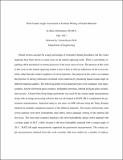Fluid Contact Angle Assessment to Evaluate Wetting of Dental Materials
Author
Abdelsalam, Rana
Abstract
Dental crowns account for a large percentage of restorative dental procedures, but the crown materials have been shown to cause wear on the natural opposing tooth. There is uncertainty regarding which mechanical or chemical process is the exact cause of wear. The premise of this work is that wear on the natural opposing enamel is due to lack of salivary adherence on the crown material, rather than the surface roughness of crown materials. The purpose of this work is to evaluate the presence of salivary lubrication on dental crown materials by measuring liquid contact angle on different material samples. The following dental crown materials types were evaluated: resin nano-ceramics, leucite-reinforced glass-ceramics, feldspathic porcelain, lithium disilicate glass ceramic, and zirconia. A Ram[copyright]·-Hart Drop Image goniometer was used for the contact angle measurements along with an image processing software that was developed in MATLAB to complement the goniometer measurements. Statistical analysis was done via JMP software using the Tukey-Kramer method for multiple comparison analysis of the different materials. The results showed that some crown material were more hydrophobic than others, hence adequate wetting of the material did not occur. The resin nano-ceramics material is the most hydrophobic dental crown material with a contact angle of 60.5[degrees], while zirconia is the most hydrophilic material with a contact angle of 20.4[degrees]. MATLAB angle measurements supported the goniometer measurements. The contact angle measurements obtained from this work correlate with wear studies by a number of authors. This work provides the first known experimental results to investigate the effect of lubrication on different crown materials.
Date
2017-04-27
Citation:
APA:
Abdelsalam, Rana.
(April 2017).
Fluid Contact Angle Assessment to Evaluate Wetting of Dental Materials
(Master's Thesis, East Carolina University). Retrieved from the Scholarship.
(http://hdl.handle.net/10342/6147.)
MLA:
Abdelsalam, Rana.
Fluid Contact Angle Assessment to Evaluate Wetting of Dental Materials.
Master's Thesis. East Carolina University,
April 2017. The Scholarship.
http://hdl.handle.net/10342/6147.
April 25, 2024.
Chicago:
Abdelsalam, Rana,
“Fluid Contact Angle Assessment to Evaluate Wetting of Dental Materials”
(Master's Thesis., East Carolina University,
April 2017).
AMA:
Abdelsalam, Rana.
Fluid Contact Angle Assessment to Evaluate Wetting of Dental Materials
[Master's Thesis]. Greenville, NC: East Carolina University;
April 2017.
Collections
Publisher
East Carolina University

